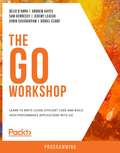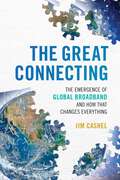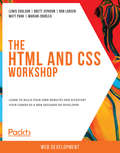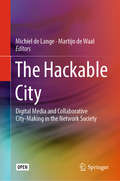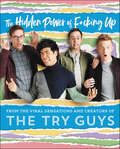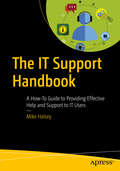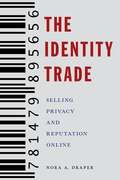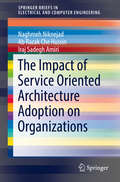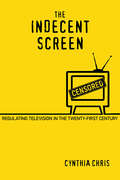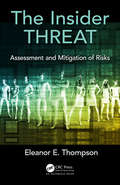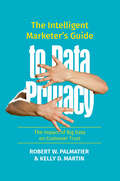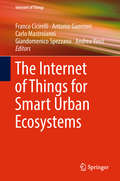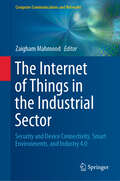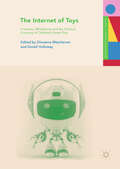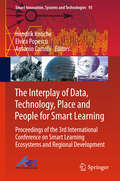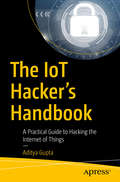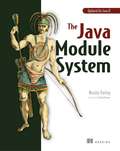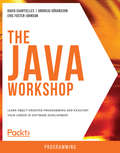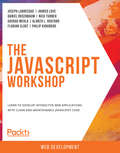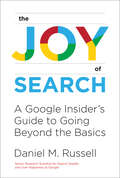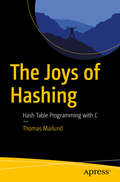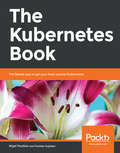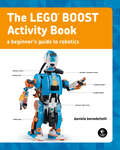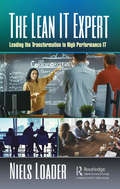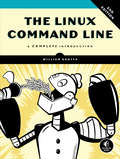- Table View
- List View
The Go Workshop: A New, Interactive Approach to Learning Go
by Dániel Szabó Delio D'Anna Andrew Hayes Sam Hennessy Jeremy Leasor Gobin SougrakpamCut through the noise and get real results with a step-by-step approach to learning Go programming Key Features Ideal for the Go beginner who is getting started for the first time A step-by-step Go tutorial with exercises and activities that help build key skills Structured to let you progress at your own pace, on your own terms Use your physical print copy to redeem free access to the online interactive edition Book Description You already know you want to learn Go, and the smart way to learn anything is to learn by doing. The Go Workshop focuses on building up your practical skills so that you can develop high-performing concurrent applications, or even create Go scripts to automate repetitive daily tasks. You'll learn from real examples that lead to real results. Throughout The Go Workshop, you'll take an engaging step-by-step approach to understanding Go. You won't have to sit through any unnecessary theory. If you're short on time you can jump into a single exercise each day, or you can spend an entire weekend learning how to test and secure your Go applications. It's your choice. Learning on your terms, you'll build up and reinforce key skills in a way that feels rewarding. Every physical print copy of The Go Workshop unlocks access to the interactive edition. With videos detailing all exercises and activities, you'll always have a guided solution. You can also benchmark yourself against assessments, track your progress, and receive content updates. You'll even earn secure credentials that you can share and verify online upon completion. It's a premium learning experience that's included with your printed copy. To redeem it, follow the instructions located at the start of your Go book. Fast-paced and direct, The Go Workshop is the ideal companion for Go beginners. You'll build and iterate on your code like a software developer, learning along the way. This process means that you'll find that your new skills stick, embedded as best practice. A solid foundation for the years ahead. What you will learn Get to grips with Go fundamentals and best practices Learn how to effectively organize your code for production environments Explore how third-party packages can help make you a better engineer Keep your development process bug-free with unit tests and benchmarks Who this book is for Our goal at Packt is to help you be successful, in whatever it is you choose to do. The Go Workshop is an ideal Go tutorial for the Go beginner who is just getting started. Pick up a Workshop today, and let Packt help you develop skills that stick with you for life.
The Great Connecting: The Emergence of Global Broadband and How That Changes Everything
by Jim CashelJim Cashel shares his predictions of what may be the biggest event in human history, and it will happen in just the next few years. For the first time, affordable broadband will reach even the poorest and most remote of global citizens, giving access to information, communications, identity authentication, government programs, global philanthropy, online banking, telehealth, distance education, and other powerful services heretofore impossible. Cashel speaks with the major players driving the broadband revolution and travels to the most remote corners of the globe to consider the changes in our world about to take place.
The HTML and CSS Workshop: A New, Interactive Approach to Learning HTML and CSS
by Rob Larsen Lewis Coulson Brett Jephson Matt Park Marian ZburleaCut through the noise and get real results with a step-by-step approach to learning HTML and CSS programming Key Features An HTML and CSS tutorial with step-by-step exercises and activities Structured to let you progress at your own pace, on your own terms Use your physical print copy to redeem free access to the online interactive edition Book Description You already know you want to learn HTML and CSS, and a smarter way to learn HTML and CSS is to learn by doing. The HTML and CSS Workshop focuses on building up your practical skills so that you can build your own static web pages from scratch, or work with existing themes on modern platforms like WordPress and Shopify. It's the perfect way to get started with web development. You'll learn from real examples that lead to real results. Throughout The HTML and CSS Workshop, you'll take an engaging step-by-step approach to beginning HTML and CSS development. You won't have to sit through any unnecessary theory. If you're short on time you can jump into a single exercise each day or spend an entire weekend learning about CSS pre-processors. It's your choice. Learning on your terms, you'll build up and reinforce key skills in a way that feels rewarding. Every physical print copy of The HTML and CSS Workshop unlocks access to the interactive edition. With videos detailing all exercises and activities, you'll always have a guided solution. You can also benchmark yourself against assessments, track progress, and receive free content updates. You'll even earn a secure credential that you can share and verify online upon completion. It's a premium learning experience that's included with your printed copy. To redeem, follow the instructions located at the start of your HTML CSS book. Fast-paced and direct, The HTML and CSS Workshop is the ideal companion for a HTML and CSS beginner. You'll build and iterate on your code like a software developer, learning along the way. This process means that you'll find that your new skills stick, embedded as best practice. A solid foundation for the years ahead. What you will learn Get to grips with the key features of HTML5 and CSS3 Learn how to integrate animation, media, and custom themes Understand how you can easily customize and maintain CSS Develop your own mobile-first approach while designing websites Learn how to diagnose and resolve common style and structural problems Who this book is for Our goal at Packt is to help you be successful, in whatever it is you choose to do. The HTML and CSS Workshop is an ideal HTML and CSS tutorial for the HTML and CSS beginner who is just getting started. Pick up a Workshop today, and let Packt help you develop skills that stick with you for life.
The Hackable City: Digital Media and Collaborative City-Making in the Network Society
by Michiel De Lange Martijn De WaalThis open access book presents a selection of the best contributions to the Digital Cities 9 Workshop held in Limerick in 2015, combining a number of the latest academic insights into new collaborative modes of city making that are firmly rooted in empirical findings about the actual practices of citizens, designers and policy makers. It explores the affordances of new media technologies for empowering citizens in the process of city making, relating examples of bottom-up or participatory practices to reflections about the changing roles of professional practitioners in the processes, as well as issues of governance and institutional policymaking.
The Hidden Power of F*cking Up
by The Try Guys Keith Habersberger Zach Kornfeld Eugene Lee Yang#1 NEW YORK TIMES BESTSELLERThe Try Guys deliver their first book—an inspirational self-improvement guide that teaches you that the path to success is littered with humiliating detours, embarrassing mistakes, and unexpected failures.To be our best selves, we must become secure in our insecurities. In The Hidden Power of F*cking Up, The Try Guys - Keith, Ned, Zach, and Eugene - reveal their philosophy of trying: how to fully embrace fear, foolishness, and embarrassment in an effort to understand how we all get paralyzed by a fear of failure. They’ll share how four shy, nerdy kids have dealt with their most poignant life struggles by attacking them head-on and reveal their - ahem - sure-fail strategies for achieving success.But they’re not just here to talk; they’re actually going to put their advice to work. To demonstrate their unique self-improvement formula, they’ll each personally confront their deepest insecurities. A die-hard meat-lover goes vegan for the first time. A straight-laced father transforms into a fashionista. A perpetually single sidekick becomes the romantic lead. A child of divorce finally grows more intimate with his family. Through their insightful, emotional journeys and surprising, hilarious anecdotes, they’ll help you overcome your own self-doubt to become the best, most f*cked up version of yourself you can be!
The IT Support Handbook: A How-To Guide to Providing Effective Help and Support to IT Users
by Mike HalseyBecome a more effective tech professional by learning how to provide the most useful IT support for your users. You'll learn how to efficiently and effectively deal with any type of problem, including operating systems, software, and hardware. IT support is often complex, time-consuming, and expensive, but it doesn't have to be with the right processes in place.Whether you're an individual, part of an IT support team, or managing staff supporting PC users in their homes, The IT Support Handbook will help you understand the right way to approach, troubleshoot, and isolate problems so they can be handled efficiently, with least disruption and cost to your business. You'll make yourself popular with your colleagues, and keep your customers and users happy and productive.What You'll LearnManage reporting, and keep a record of issues that occurProvide effective remote support for users away from home or working in another officeUse error and system reporting in Windows to obtain high-quality, relevant informationSpot patterns in user behavior that may be causing difficult-to-diagnose problemsBe familiar with best practices to make you a better support professionalWho This Book Is ForIT professionals, IT support (on-site and remote), and system administrators who manage support teams. No prior knowledge is required.
The Identity Trade: Selling Privacy and Reputation Online (Critical Cultural Communication #7)
by Nora A. DraperThe successes and failures of an industry that claims to protect and promote our online identitiesWhat does privacy mean in the digital era? As technology increasingly blurs the boundary between public and private, questions about who controls our data become harder and harder to answer. Our every web view, click, and online purchase can be sold to anyone to store and use as they wish. At the same time, our online reputation has become an important part of our identity—a form of cultural currency.The Identity Trade examines the relationship between online visibility and privacy, and the politics of identity and self-presentation in the digital age. In doing so, Nora Draper looks at the revealing two-decade history of efforts by the consumer privacy industry to give individuals control over their digital image through the sale of privacy protection and reputation management as a service.Through in-depth interviews with industry experts, as well as analysis of media coverage, promotional materials, and government policies, Draper examines how companies have turned the protection and promotion of digital information into a business. Along the way, she also provides insight into how these companies have responded to and shaped the ways we think about image and reputation in the digital age.Tracking the successes and failures of companies claiming to control our digital ephemera, Draper takes us inside an industry that has commodified strategies of information control. This book is a discerning overview of the debate around who controls our data, who buys and sells it, and the consequences of treating privacy as a consumer good.
The Impact of Service Oriented Architecture Adoption on Organizations (SpringerBriefs in Electrical and Computer Engineering)
by Iraj Sadegh Amiri Naghmeh Niknejad Ab Razak HussinThis book describes Service-Oriented Architecture (SOA) and the significant factors which affect its adoption, such as governance, strategy, complexity, Return on Investment (ROI), business and IT alignment, culture and communication, costs, and security. The study on which this book is based, involved a quantitative analysis to investigate the influential factors for adopting SOA, paving the way to further research in the field.
The Indecent Screen: Regulating Television in the Twenty-First Century
by Cynthia ChrisThe Indecent Screen explores clashes over indecency in broadcast television among U.S.-based media advocates, television professionals, the Federal Communications Commission, and TV audiences. Cynthia Chris focuses on the decency debates during an approximately twenty-year period since the Telecommunications Act of 1996, which in many ways restructured the media environment. Simultaneously, ever increasing channel capacity, new forms of distribution, and time-shifting (in the form of streaming and on-demand viewing options) radically changed how, when, and what we watch. But instead of these innovations quelling concerns that TV networks were too often transmitting indecent material that was accessible to children, complaints about indecency skyrocketed soon after the turn of the century. Chris demonstrates that these clashes are significant battles over the role of family, the role of government, and the value of free speech in our lives, arguing that an uncensored media is so imperative to the public good that we can, and must, endure the occasional indecent screen.
The Insider Threat: Assessment and Mitigation of Risks
by Eleanor E. ThompsonThis book provides emergent knowledge relating to physical, cyber, and human risk mitigation in a practical and readable approach for the corporate environment. It presents and discusses practical applications of risk management techniques along with useable practical policy change options. This practical organizational security management approach examines multiple aspects of security to protect against physical, cyber, and human risk. A practical more tactical focus includes managing vulnerabilities and applying countermeasures. The book guides readers to a greater depth of understanding and action-oriented options.
The Intelligent Marketer’s Guide to Data Privacy: The Impact of Big Data on Customer Trust
by Robert W. Palmatier Kelly D. MartinFirms are collecting and analyzing customer data at an ever increasing rate in response to evidence that data analytics (precision targeting, improved selling) generates a positive return. Yet efforts often ignore customers’ privacy concerns and feelings of vulnerability with long-term effects on customers’ trust, relationships, and ultimately financial performance. Big data, privacy, and cybersecurity often is relegated to IT and legal teams with minimal regard for customer relationships. This book fills the void by taking a customer-centric approach to privacy. It offers both defensive and offensive marketing-based privacy strategies that strongly position firms in today’s data-intensive landscape. The book also helps managers anticipate future consumer and legislative trends. Drawing from the authors’ own work and extant research, this book offers a compelling guide for building and implementing big data- and privacy-informed business strategies. Specifically, the book: · -Describes the consumer psychology of privacy · -Deconstructs relevant legal and regulatory issues · - Offers defensive privacy strategies · - Describes offensive privacy strategies · Provides an executive summary with the Six Tenets for Effective Privacy Marketing This book will be useful to managers, students, or the casual reader who is interested in how and why big data and consumer privacy are transforming business. Moving beyond summary privacy insights, the book also offers a detailed and compelling action plan for improving performance by protecting against privacy threats as well as developing and implementing offensive privacy strategy. In the future, many firms will be competing through an integrated, customer-centric big data privacy strategy and this book will guide managers in this journey.
The Internet of Things for Smart Urban Ecosystems (Internet of Things)
by Antonio Guerrieri Giandomenico Spezzano Franco Cicirelli Carlo Mastroianni Andrea VinciThe main objective of this book is to provide a multidisciplinary overview of methodological approaches, architectures, platforms, and algorithms for the realization of an Internet of Things (IoT)-based Smart Urban Ecosystem (SUE). Moreover, the book details a set of real-world applications and case studies related to specific smart infrastructures and smart cities, including structural health monitoring, smart urban drainage networks, smart grids, power efficiency, healthcare, city security, and emergency management. A Smart Urban Ecosystem (SUE) is a people-centric system of systems that involves smart city environments, applications, and infrastructures. SUEs require the close integration of cyber and physical components for monitoring, understanding and controlling the urban environment. In this context, the Internet of Things (IoT) offers a valuable enabling technology, as it bridges the gap between physical things and software components, and empowers cooperation between distributed, pervasive, and heterogeneous entities.
The Internet of Things in the Industrial Sector: Security and Device Connectivity, Smart Environments, and Industry 4.0 (Computer Communications and Networks)
by Zaigham MahmoodThis book has a focus on the development and deployment of the Industrial Internet of Things (IIoT) paradigm, discussing frameworks, methodologies, benefits and limitations, as well as providing case studies of employing the IoT vision in the industrial domain. IIoT is becoming an attractive business reality for many organisations such as manufacturing, logistics, oil and gas, energy and other utilities, mining, aviation, and many more. The opportunities for this paradigm are huge, and according to one report, the IIoT market is predicted to reach $125 billion by 2021. The driving philosophy behind the IIoT is that smart machines are better than humans at accurately capturing, analysing and communicating real-time data. The underlying technologies include distributed computing, machine learning, artificial intelligence, and machine-to-machine communication, with a typical IIoT system consisting of intelligent systems (applications, controllers, sensors, and security mechanisms), data communication infrastructure (cloud computing, edge computing, etc.), data analytics (to support business intelligence and corporate decision making), and most importantly the human element. The promised benefits of the IIoT include enhanced safety, better reliability, smart metering, inventory management, equipment tracking, and facilities management. There are, however, numerous issues that are also becoming the focus of active research, such as concerns regarding service availability, data security, and device communication. Lack of ubiquitous interoperability between heterogeneous devices is also a major concern. This book intends to fill a gap in the IIoT literature by providing the scientific contributions and latest developments from researchers and practitioners of international repute, focusing on frameworks, methodologies, benefits, and inherent issues/barriers to connected environments, especially in industrial settings.The intended audience includes network specialists, hardware engineers, and security experts who wish to adopt newer approaches for device connectivity, IoT security, and sensor-based devices design. University level students, researchers and practitioners will also find the latest innovation in technology and newer approaches relevant to the IIoT from a distributed computing perspective.
The Internet of Toys: Practices, Affordances and the Political Economy of Children’s Smart Play (Studies in Childhood and Youth)
by Giovanna Mascheroni Donell HollowayThe Internet of Toys (IoToys) is a developing market within our Internet of Things (IoT) ecosystem. This book examines the rise of internet-connected toys and aims to anticipate the opportunities and risks of IoToys before their widespread diffusion. Contributors to this volume each provide a critical analysis of the design, production, regulation, representation and consumption of internet-connected toys. In order to address the theoretical, methodological and policy questions that arise from the study of these new playthings, and contextualise the diverse opportunities and challenges that IoToys pose to educators, families and children themselves, the chapters engage with notions of mediatization, datafication, robotification, connected and post-digital play. This timely engagement with a key transformation in children’s play will appeal to all readers interested in understanding the social uses and consequences of IoToys, and primarily to researchers and students in children and media, early childhood studies, media and communications, sociology, education, social psychology, law and design.
The Interplay of Data, Technology, Place and People for Smart Learning: Proceedings Of The 3rd International Conference On Smart Learning Ecosystems And Regional Development (Smart Innovation, Systems And Technologies #95)
by Elvira Popescu Hendrik Knoche Antonio CartelliThis book gathers contributions to the 3rd International Conference on Smart Learning Ecosystems and Regional Developments (SLERD 2018), held at Aalborg University, Denmark on 23–25 May 2018. What characterizes smart learning ecosystems? What is their role in city and regional development and innovation? How can we promote citizen engagement in smart learning ecosystems? These are some of the questions addressed at SLERD 2018 and documented in these proceedings, which include a diverse range of papers intended to help understand, conceive, and promote innovative human-centric design and development methods, education/training practices, informal social learning, and citizen-driven policies. The papers elaborate on the notion of smart learning ecosystems, assess the relation of smart learning ecosystems with their physical surroundings, and identify new resources for smart learning. SLERD 2018 contributes to foster the social innovation sectors, ICT and economic development and deployment strategies, as well as new policies for smarter, more proactive citizens. As such, these proceedings are relevant for researchers and policymakers alike.
The IoT Hacker's Handbook: A Practical Guide to Hacking the Internet of Things
by Aditya GuptaTake a practioner’s approach in analyzing the Internet of Things (IoT) devices and the security issues facing an IoT architecture. You’ll review the architecture's central components, from hardware communication interfaces, such as UARTand SPI, to radio protocols, such as BLE or ZigBee. You'll also learn to assess a device physically by opening it, looking at the PCB, and identifying the chipsets and interfaces. You'll then use that information to gain entry to the device or to perform other actions, such as dumping encryption keys and firmware. As the IoT rises to one of the most popular tech trends, manufactures need to take necessary steps to secure devices and protect them from attackers. The IoT Hacker's Handbook breaks down the Internet of Things, exploits it, and reveals how these devices can be built securely.What You’ll LearnPerform a threat model of a real-world IoT device and locate all possible attacker entry points Use reverse engineering of firmware binaries to identify security issues Analyze,assess, and identify security issues in exploited ARM and MIPS based binariesSniff, capture, and exploit radio communication protocols, such as Bluetooth Low Energy (BLE), and ZigBeeWho This Book is ForThose interested in learning about IoT security, such as pentesters working in different domains, embedded device developers, or IT people wanting to move to an Internet of Things security role.
The Java Module System
by Nicolai ParlogSummaryJava's much-awaited "Project Jigsaw" is finally here! Java 11 includes a built-in modularity framework, and The Java Module System is your guide to discovering it. In this new book, you'll learn how the module system improves reliability and maintainability, and how it can be used to reduce tight coupling of system components.Foreword by Kevlin Henney.Purchase of the print book includes a free eBook in PDF, Kindle, and ePub formats from Manning Publications. You'll find registration instructions inside the print book.About the TechnologyPackaging code into neat, well-defined units makes it easier to deliver safe and reliable applications. The Java Platform Module System is a language standard for creating these units. With modules, you can closely control how JARs interact and easily identify any missing dependencies at startup. This shift in design is so fundamental that starting with Java 9, all core Java APIs are distributed as modules, and libraries, frameworks, and applications will benefit from doing the same.About the BookThe Java Module System is your in-depth guide to creating and using Java modules. With detailed examples and easy-to-understand diagrams, you'll learn the anatomy of a modular Java application. Along the way, you'll master best practices for designing with modules, debugging your modular app, and deploying to production.What's insideThe anatomy of a modular Java appBuilding modules from source to JARMigrating to modular JavaDecoupling dependencies and refining APIsHandling reflection and versioningCustomizing runtime imagesUpdated for Java 11About the ReaderPerfect for developers with some Java experience.About the AuthorNicolai Parlog is a developer, author, speaker, and trainer. His home is codefx.org. Table of ContentsPART 1 - Hello, modulesFirst piece of the puzzleAnatomy of a modular applicationDefining modules and their propertiesBuilding modules from source to JARRunning and debugging modular applicationsPART 2 - Adapting real-world projectsCompatibility challenges when moving to Java 9 or laterRecurring challenges when running on Java 9 or laterIncremental modularization of existing projectsMigration and modularization strategiesPART 3 - Advanced module system featuresUsing services to decouple modulesRefining dependencies and APIsReflection in a modular worldModule versions: What's possible and what's notCustomizing runtime images with jlinkPutting the pieces together
The Java Workshop: A Practical, No-Nonsense Introduction to Java Development
by Eric Foster-Johnson Andreas Goransson David CuartiellesCut through the noise and get real results with a step-by-step approach to learning Java programming Key Features Ideal for the Java beginner who is getting started for the first time A step-by-step Java tutorial with exercises and activities that help build key skills Structured to let you progress at your own pace, on your own terms Use your physical copy to redeem free access to the online interactive edition Book Description You already know you want to learn Java, and a smarter way to learn Java 12 is to learn by doing. The Java Workshop focuses on building up your practical skills so that you can develop high-performance Java applications that work flawlessly within the JVM across web, mobile and desktop. You'll learn from real examples that lead to real results. Throughout The Java Workshop, you'll take an engaging step-by-step approach to understanding Java. You won't have to sit through any unnecessary theory. If you're short on time you can jump into a single exercise each day or spend an entire weekend learning about Reactive programming and Unit testing. It's your choice. Learning on your terms, you'll build up and reinforce key skills in a way that feels rewarding. Every physical copy of The Java Workshop unlocks access to the interactive edition. With videos detailing all exercises and activities, you'll always have a guided solution. You can also benchmark yourself against assessments, track progress, and receive free content updates. You'll even earn a secure credential that you can share and verify online upon completion. It's a premium learning experience that's included with your printed copy. To redeem, follow the instructions located at the start of your Java book. Fast-paced and direct, The Java Workshop is the ideal companion for Java beginners. You'll build and iterate on your code like a software developer, learning along the way. This process means that you'll find that your new skills stick, embedded as best practice. A solid foundation for the years ahead. What you will learn Get to grips with fundamental concepts and conventions of Java 12 Write clean and well-commented code that's easy to maintain Debug and compile logical errors and handle exceptions in your programs Understand how to work with Java APIs and Java streams Learn how to use third-party libraries and software development kits (SDKs) Discover how you can work with information stored in databases Understand how you can keep data secure with cryptography and encryption Learn how to keep your development process bug-free with unit testing in Java Who this book is for Our goal at Packt is to help you be successful, in whatever it is you choose to do. The Java Workshop is an ideal Java tutorial for the Java beginner who is just getting started. Pick up a Workshop today, and let Packt help you develop skills that stick with you for life.
The JavaScript Workshop: A New, Interactive Approach to Learning JavaScript
by Joseph Labrecque Nick Turner Jahred Love Daniel Rosenbaum Gaurav MehlaFlorian
The Joy of Search: A Google Insider's Guide to Going Beyond the Basics (The\mit Press Ser.)
by Daniel M. RussellHow to be a great online searcher, demonstrated with step-by-step searches for answers to a series of intriguing questions (for example, “Is that plant poisonous?”).We all know how to look up something online by typing words into a search engine. We do this so often that we have made the most famous search engine a verb: we Google it—“Japan population” or “Nobel Peace Prize” or “poison ivy” or whatever we want to know. But knowing how to Google something doesn't make us search experts; there's much more we can do to access the massive collective knowledge available online. In The Joy of Search, Daniel Russell shows us how to be great online researchers. We don't have to be computer geeks or a scholar searching out obscure facts; we just need to know some basic methods. Russell demonstrates these methods with step-by-step searches for answers to a series of intriguing questions—from “what is the wrong side of a towel?” to “what is the most likely way you will die?” Along the way, readers will discover essential tools for effective online searches—and learn some fascinating facts and interesting stories. Russell explains how to frame search queries so they will yield information and describes the best ways to use such resources as Google Earth, Google Scholar, Wikipedia, and Wikimedia. He shows when to put search terms in double quotes, how to use the operator (*), why metadata is important, and how to triangulate information from multiple sources. By the end of this engaging journey of discovering, readers will have the definitive answer to why the best online searches involve more than typing a few words into Google.
The Joys of Hashing: Hash Table Programming with C
by Thomas MailundBuild working implementations of hash tables, written in the C programming language. This book starts with simple first attempts devoid of collision resolution strategies, and moves through improvements and extensions illustrating different design ideas and approaches, followed by experiments to validate the choices. Hash tables, when implemented and used appropriately, are exceptionally efficient data structures for representing sets and lookup tables, providing low overhead, constant time, insertion, deletion, and lookup operations. The Joys of Hashing walks you through the implementation of efficient hash tables and the pros and cons of different design choices when building tables. The source code used in the book is available on GitHub for your re-use and experiments.What You Will LearnMaster the basic ideas behind hash tablesCarry out collision resolution, including strategies for handling collisions and their consequences for performanceResize or grow and shrink tables as neededStore values by handling when values must be stored with keys to make general sets and mapsWho This Book Is ForThose with at least some prior programming experience, especially in C programming.
The Kubernetes Book: The fastest way to get your head around Kubernetes
by Nigel Poulton Pushkar JoglekarUnderstand the Kubernetes ecosystem and learn techniques to run fault-tolerant, scalable applications Key Features Gain insight into the inner workings of Kubernetes Learn how to deploy and manage applications on Kubernetes Explore ways to build and secure Kubernetes clusters Book Description Kubernetes is the leading orchestrator of cloud-native apps. With knowledge of how to work with Kubernetes, you can easily deploy and manage applications on the cloud or in your on-premises data center. The book begins by introducing you to Kubernetes and showing you how to install it. You'll learn how to use Kubernetes Services and bring stable and reliable networking to apps that are deployed on Kubernetes. You'll delve deep into the powerful storage subsystem of Kubernetes and learn how to leverage the variety of external storage backends in your applications. As the book progresses, it shows you how to use features such as DaemonSets, Helm, and RBAC to enhance your Kubernetes applications. You'll explore the six categories of identifying vulnerabilities and look at a few ways to prevent and mitigate them. You'll also look at ways to secure the software delivery pipeline by discussing some image-related best practices. The book ends by sharing with you some resources that'll help take your Kubernetes knowledge to the next level. By the end of the book, you'll have the confidence and skills to leverage all the features of Kubernetes to develop scalable applications. What you will learn Explore cluster-level and node-level isolation and runtime isolation options Use Kubernetes Deployments for self-healing, scaling, and updating apps Manage Kubernetes clusters with kubectl Write a Container Storage Interface (CSI) plugin to work across multiple orchestrators Use Kubernetes features such as Jons and CronJobs in your apps Identify vulnerabilities and learn measures to prevent and mitigate them Who this book is for If you want to be more comfortable using Kubernetes to orchestrate your containerized applications, this is the ideal book for you. To easily grasp the concepts explained in this book, you must be familiar with Docker and containers.
The LEGO BOOST Activity Book
by Daniele BenedettelliAt last, fans of the LEGO BOOST robot building kit have the learning resource they've been missing! Enter The LEGO BOOST Activity Book: a full-color guide that will help readers learn how to build and code LEGO creations that move, explore their environment, grab and lift objects, and more.The LEGO BOOST kit lets younger builders create fun, multifunctional robots by combining bricks with code, but it doesn't come with a manual. With the help of this complete guide to the LEGO BOOST set, you'll be on your way to building and programming BOOST robots in no time.You'll begin your exploration by building a basic rover robot called MARIO to help you learn the fundamentals of the BOOST programming environment. Next, you'll add features to your rover to control its movement and make it repeat actions and react to colors and sounds. Once you've learned some programming basics, you'll learn how to program your robot to do things like follow lines on the ground, scan its environment to decide where to go, and even play darts. As final projects, you'll create two complete robots: BrickPecker to help you organize your bricks and CYBOT, a robot that talks, shoots objects, and executes voice commands. As you advance through the book, optional lessons aim to deepen your understanding of basic robotics concepts. Brain BOOSter sections let you dig into the math and engineering behind your builds while a host of experiments seek to test your skills and encourage you to do more with your robots. With countless illustrations, extensive explanations, and a wealth of coding examples to guide you, The LEGO BOOST Activity Book is sure to take you from beginning builder to robotics whiz and give your robot-building brain that needed boost!
The Lean IT Expert: Leading the Transformation to High Performance IT
by Niels LoaderDigital transformation is a business concern; it is no longer just IT that must get things done. The disruptive force of start-ups focusing on IT-based services that can be consumed through mobile devices cannot be underestimated -- These start-ups eat away at the high-margin services provided by incumbents, leaving lower margin products and services that are rapidly being commoditized. This is happening in all industry sectors and it is the ones who are best able to adjust, innovate, and improve their service offerings that will survive. The question is: What do you need to do to ensure that your organization is one of the survivors? The core of the solution to the problem is to radically improve the way the IT organization works together with the business. To be clear, the digital transformation of your business depends on that relatively small group of people in the basement, or other out-of-the-way location, who make sure that your IT services work. So, building a cooperative model is vital for the success of the business. Which model has proven its worth in many industries? It is the application of Lean principles that gives organizations an advantage in delivering their products and services to their customers. Transforming your organization to high performance is, above all, a people-based movement with the acquisition and, most importantly, application of knowledge and skills necessary for the high performance way of working at its core. In teams, from boardroom to work floor, building a new way of thinking and acting is essential. This book aims to give insight into the reasons why you and your organization must consciously act to apply Lean principles to your IT organization. It explains the phases organizations go through as they start out with their initial attempts to gain advantages from Lean tools to the phase in which they reap the strategic benefits of Lean applied to IT. The real work of the transformation is described from two different perspectives: Leadership and Team. This book describes a complete set of principles, practices and tools In order to make the right decisions along the winding route of your transformation. The people who will guide, support and drive your transformation are the leaders and tem members who understand and apply those principles, practice and tools: your Lean IT Experts.
The Linux Command Line: A Complete Introduction
by Jr. William E. ShottsYou've experienced the shiny, point-and-click surface of your Linux computer--now dive below and explore its depths with the power of the command line.The Linux Command Line takes you from your very first terminal keystrokes to writing full programs in Bash, the most popular Linux shell (or command line). Along the way you'll learn the timeless skills handed down by generations of experienced, mouse-shunning gurus: file navigation, environment configuration, command chaining, pattern matching with regular expressions, and more.In addition to that practical knowledge, author William Shotts reveals the philosophy behind these tools and the rich heritage that your desktop Linux machine has inherited from Unix supercomputers of yore.As you make your way through the book's short, easily-digestible chapters, you'll learn how to: * Create and delete files, directories, and symlinks * Administer your system, including networking, package installation, and process management * Use standard input and output, redirection, and pipelines * Edit files with Vi, the world's most popular text editor * Write shell scripts to automate common or boring tasks * Slice and dice text files with cut, paste, grep, patch, and sedOnce you overcome your initial "shell shock," you'll find that the command line is a natural and expressive way to communicate with your computer. Just don't be surprised if your mouse starts to gather dust.
